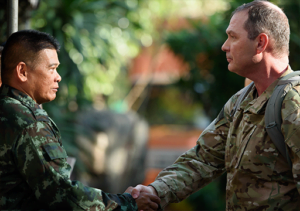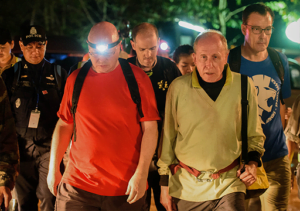
A look back at the Nang Non Cave Rescue in Thailand, 2018 (Pt 2)
Part 2: The Rescue
As a man once said, “Once you make a decision, the universe conspires to make it happen.”
The shaky film of the boys’ discovery shot across the world and the world breathed a massive sigh of relief. The boys had been found, safe and, though famished, quite well in the circumstances. They were there, on a mud bank, football shirts pulled over bare knees desperately seeking a hint of warmth against their hungry immobile chill.
Back at base camp, the euphoria over finding the boys could not last long. The next question had to be faced, ‘how do we get them out?’

To recap the facts; there were 12 boys aged 11 to 16 plus their 25-year-old coach. All were in reasonable health but visibly weak having eaten almost nothing for 10 days. Some couldn’t swim, none could dive, none had experience of wearing diving masks or breathing equipment.
The boys were on a kind of ledge 4 km inside the cave. The route out would be through a series of passages most of which were flooded with murky floodwater, the water visibility was often down to zero, in some places the water still flowed with a strong current. At some points, the passages were extremely narrow measuring as little as 38 by 72 centimetres. Other points were very low. It took the experienced divers 5 hours to reach the mouth of the cave after leaving the boys. So, how to get them out?
The Thais sent down a team including medics loaded with supplies and nutrition, they would stay with the boys giving them confidence that their nightmare would soon be over. The English diver Jason Mallinson offered the boys and their coach an opportunity to write messages to their families on a ‘wet note’ pad. This was important for the boys’ morale, providing another vital link with the world outside.
Back at base, the various groups met. How could they get them out? Everything was open to consideration. Could the boys be taught to swim….and dive? Could they be taught how to use the breathing equipment? Knowing that it would be months before the water receded, could the boys stay there, on that ledge….for another 3 months, and when the waters allowed, walk out? Searches had already been made for other entry/exit points. Could escape holes be bored through the rock to the boys?
Whatever, a decision had to be made fast. Air oxygen levels were dropping to the point where they would be harmful. Thai military engineers tried to install an air supply but in time realised it was impractical and abandoned the idea. It was the weather forecast though that forced the rescuers’ hands, further heavy rain would fall later on in the week, the weather would win the battle and inundate the cave; the rescue had to start on the 8th of July……..
In the end, a solution was agreed between all parties. But it was novel, possibly controversial and definitely very risky but every option was risky; this really was life and death. Still, before they commenced the rescuers sought and received the agreement of the parents and the highest levels of the Thai government.
The decision was made to anaesthetise the boys. Each boy would wear a positive pressure full-face diving mask which would enable him to continue breathing. They would then be tethered to the body of the rescue diver. This would enable the diver to manoeuvre the boy ensuring his head didn’t hit the rock and his mask remained in place. Top Australian anaesthetist and diver Dr Richard Harris assisted by compatriot medic Crag Challen administered the anaesthetic, they also taught members of the support team to do the same as it (the anaesthetic) would wear off after 45-60 minutes, further injections would be required. The international cave diving team was led by the four British divers John Volanthen, Richard Stanton, Jason Mallinson, Chris Jewell.

Internationally there was some surprise that the decision had been made to anaesthetise the boys, but it was necessary, remember that the boys were unable to dive, many couldn’t swim, there was too much of a danger that once in the water the boys would panic and put not just themselves but also the divers lives at risk.
The first two boys, Nick and Note were chosen, apparently the team decided amongst themselves that the 2 members who lived furthest away should go first-the boys were quite disorientated, they had no idea of how this had become a global story and had completely lost track of time; the ones who lived furthest away should be able to get on their bikes and ride home and tell everybody that they were alright and that the rest would be home soon they surmised !……
The boys were anaesthetised and tethered to the divers and they set off. The divers later spoke of their feeling of responsibility having this young life strapped to theirs, they knew they had to be cautious, they knew they had to do everything; every movement, every turn, every surface to the very best of their ability to ensure that the boys stood the best chance of survival. Control of cms to ensure that the boys didn’t hit their heads on the rock and crucially ensuring that the face masks stayed in place, could be the difference between life and death; the highest stakes; tension; but the rescuers knew their best chance and the boys’ best chance lay in their being cool and thus able to think and move as efficiently as possible.
And, it worked.
In the morning of the 8th of July non-essential personnel were requested to clear the immediate area as the rescue would start. But the wait continued…… then, in the early evening a buzz of excitement spread back from the entrance, the first boy had arrived. Strapped to a stretcher and covered with a blanket he was carefully placed in the ambulance and sped away; happiness and relief were everywhere but it couldn’t yet be total, he was one, there were 12 more to come, and how was he? They had only seen a body strapped to a stretcher……
Over the following 48 hours, the dive teams repeated the protocol. Two divers, a boy each, support divers stationed along the route and the Thai teams in situ further along ready to take over and bring them through the last part, and out, into the world. Soon after they arrived outside, each boy was whisked away to Chiang Rai Prachanukroh Hospital where a special ward had been set up ready to receive them. The boys would have to spend some time in isolation there, under observation and with focussed medical support after spending so long underground and without food. Their dreams of the local fried chicken delicacy which had variously sustained and tortured them through their days lost would have to wait!
So, it worked! All 13 members of the team were rescued and the next day the world saw them in the hospital ward, all apparently well, both physically and mentally.
The universe and the fates conspired to make it happen, miracles can happen!
Philip Wilson
October 2019
The first film about the rescue of the Wild Boars, ‘The Cave’ by Thai-Irish Producer -Director Tom Waller will be released on November 2019. The film recounts the story from the points of view of several of the people instrumental to the rescue; the divers, the US army sergeant and local officials. Several of these people including divers Jim Warny (Belgium), Erik Brown(Canada), Mikko Passi (Finland) and Tan Xioo Long (China) play themselves in the film ensuring its accuracy and authenticity. The film recounts the search and then the planning and ultimate rescue which to the world’s relief ended in success. Look out for it!
Note: All photos and images reproduced by kind courtesy De Warranne Pictures